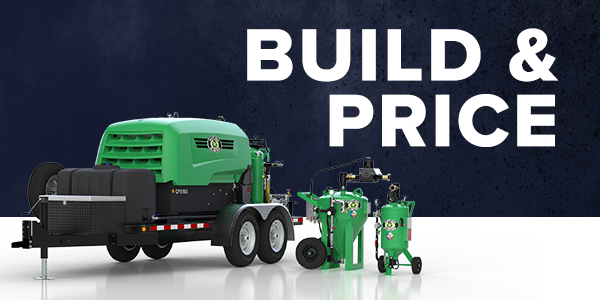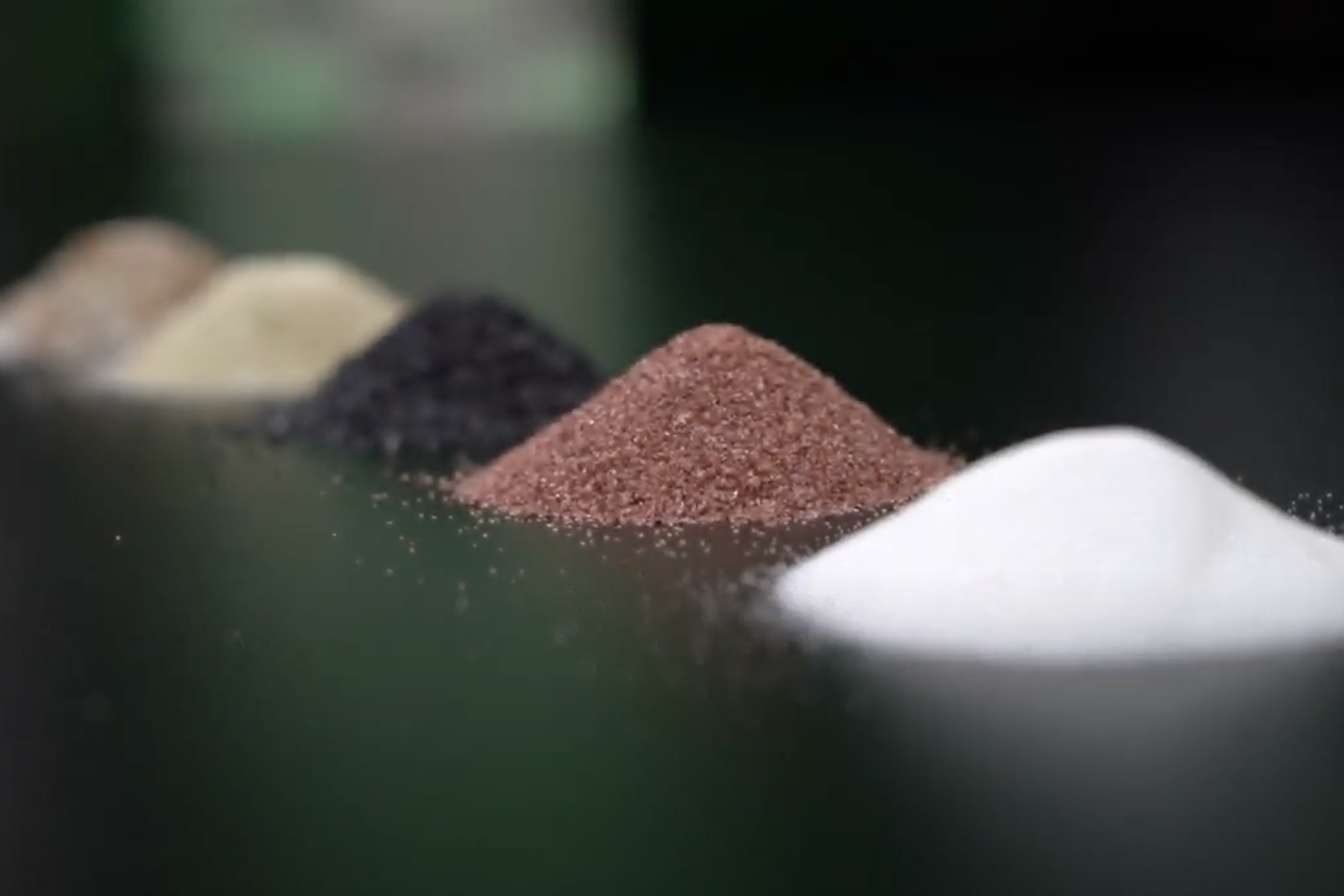Sandblasting: The Process of Stripping Away the Old to Reveal the New
Free Download
The Dustless Blasting Equipment Catalog
Equipment, pricing, and the mobile blasting business opportunity.
Get the Catalog
Sandblasting is a process that has been around for decades. It’s used to clean, etch, and prepare surfaces before painting or coating them with another material. Unfortunately, sandblasters are machines that produce high noise levels and dust that can be dangerous if not operated properly. For that reason, sand as a blasting media is not recommended as it can be damaging to one's health over time and is not environmentally friendly. In fact, sandblasting is often referred to as "dry abrasive blasting" because the process has changed over time and no longer really uses sand as a blasting media. In this guide, we will explain what sandblasting is, why, despite the name, sand is not the preferred blasting media, applications and uses, the recommended sandblasting equipment, and more.
So, let's explore sandblasting!
What is Sandblasting?
Sandblasting is the act of forcing solid particles of abrasive blasting material (such as sand) against a hard surface to smooth it or roughen it, remove paint or modify its surface characteristics. A sand blaster uses high pressure to accelerate dry silica particles to speeds fast enough to erode metal and other materials at a microscopic level.
Sandblasting is commonly used to clean and prepare surfaces, but it can also be used to remove paint or create decorative effects on buildings, signage, boats etc.
The Sandblasting Process
There are several methods and tools that fall under the umbrella of sandblasting:
First and foremost there is abrasive blasting. This method consists of propelling a stream of abrasive material via compressed air at a surface to smooth, roughen or otherwise modify it.
One of the most common alternatives to sandblasting is glass bead blasting or grit blasting. This method uses a stream of very small glass beads propelled by compressed air. The stream of beads impact the surface at high speed and scour it, removing dirt and other unwanted materials. Glass bead blasting is typically used for production work and therefore the glass beads are reused.
Sandblasting Applications and Uses
Sandblasting is also used in the preparation of surfaces prior to painting — such as removal of old paint or rust — or to roughen a smooth surface, such as concrete, so that sprays or rollers can apply a better bond. In this case, the lower part of the object, where it is less visible, can be "rough-blasted" with large abrasive particles to provide a key for the new paint or coating.
Sandblasting is frequently used as an art form of graffiti removal. Because sandblasting both removes material and imparts a unique finish to surfaces, much fine detail or intricate designs can be achieved in this way, often through the use of templates to guide the blasting.
Click here to read our article on different uses of sandblasting
Sandblasting is a cleaning process in which sand or gravel is propelled at high speeds for surface treatments Any media that has the potential to alter the surface of an object can be supersonically ejected into it, but sand--being both round and hard--is particularly suited for blasting large areas rapidly.
.jpg?width=960&name=Scotts%20Sandblasting%20and%20Painting%20wood%20blasting%20(1).jpg)
Here are some other sandblasting uses to be aware of:
- Antiques
- Tools
- Brass
- Automotive
- Marine
- Powder Coating
- Heavy Machinery and Farm Equipment
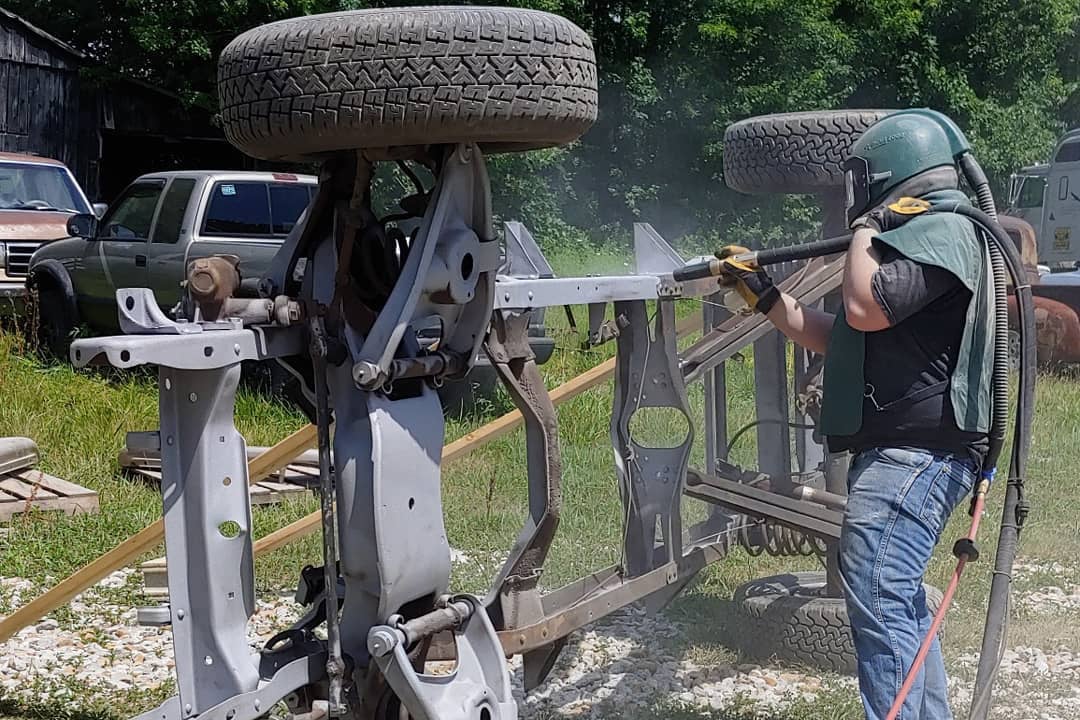
Blasting Techniques and Practices
Sandblasters are used in many different settings, but there are a few precautions that must be taken when using these machines. In any case where hard or irregular objects can take flight from the high velocity of this equipment, adequate protection should be worn to protect operators from impact wounds. Padded headgear is required for open blasting where media can take flight. For closed spaces, goggles and breathing masks should be worn to protect the eyes and lungs from hazardous particles or chemicals that may come in contact with these areas of the body. Open (or pressurized) data lines are necessary when using abrasive blasting cutting mediums such as glass, to control the escape of sparks or high heat.
The blasting area should have a containment structure, which can be used to replace the media that has been exhausted or to contain hazardous materials in the event of an explosion.
Sandblasting is not limited to large areas on big projects. Here are some uses for sand blasters:
- Remove rust and corrosion from metal
- Create a key for paint or other coatings applied to concrete or wood
- Mold removal
- Fire damage clean up
- Etch concrete surfaces to create a decorative effect
For more on the applications and uses of sandblasting, check out our blog.
Sandblasting Techniques and Tips
Before you begin sandblasting, make sure the media is not free-flowing. Fine media can be loosened by heating it in an oven for up to an hour. Not only will the heat help the material release from the blast wheel, but this application also helps prevent clogging of nozzles and makes it easier to work with.
Sandblasting Equipment
The Dustless Blasting machine is your go-to sandblaster. It's ideal for removing paint, cleaning rusted tools, restoring metal surfaces and working with plastics. The machine allows for the optimal speed for your sandblasting process.
The sandblaster creates a powerful jet stream of sand to remove dirt and loosen oil without leaving any debris or dust behind. It's perfect for cleaning large surfaces where traditional sandblasters cannot reach. Overall, this paint sprayer was designed to make painting quick, easy and efficient. If you have a big project coming up that requires laying down several coats of paint in just one go then this is the perfect machine for you. In addition, the Dustless Blasting machine is easy to use, highly efficient, and has great mobility.
Check out this ultimate guide or our Build & Price tool to help you choose which portable sandblaster is right for you and your projects.
However, regardless of what types of projects you are pursuing, there are some basic components you will want to have before you start blasting.
Here are some of the must-haves equipment wise to up your sandblasting game:
- A compressor with the capacity to supply adequate air for the abrasive and nozzle you are using
- A Blast Pot, or pressure vessel, that adds abrasives to the air or water stream.
- After cooler and moisture separator that cools hot compressed air and removes moisture before it enters your blast pot (if blasting dry).
Discover what other pieces of sandblasting equipment you will need.
Sandblasting Nozzles
When using a blast nozzle, it is important to make sure that the tip rotates at high speeds. This allows the material to be forced out of the machine's hose and onto surfaces. There are many different types of nozzles available such as:
- Straight (for rough or heavy blasting)
- Tapered (for smooth, dull or final blasting)
- Diamond (for high performance and efficiency)
- Fluted (for low pressure and gentle cleaning of soft materials like wood and cloth)
- Reinforced flutes (for heavy duty applications such as removing paint from concrete walls).
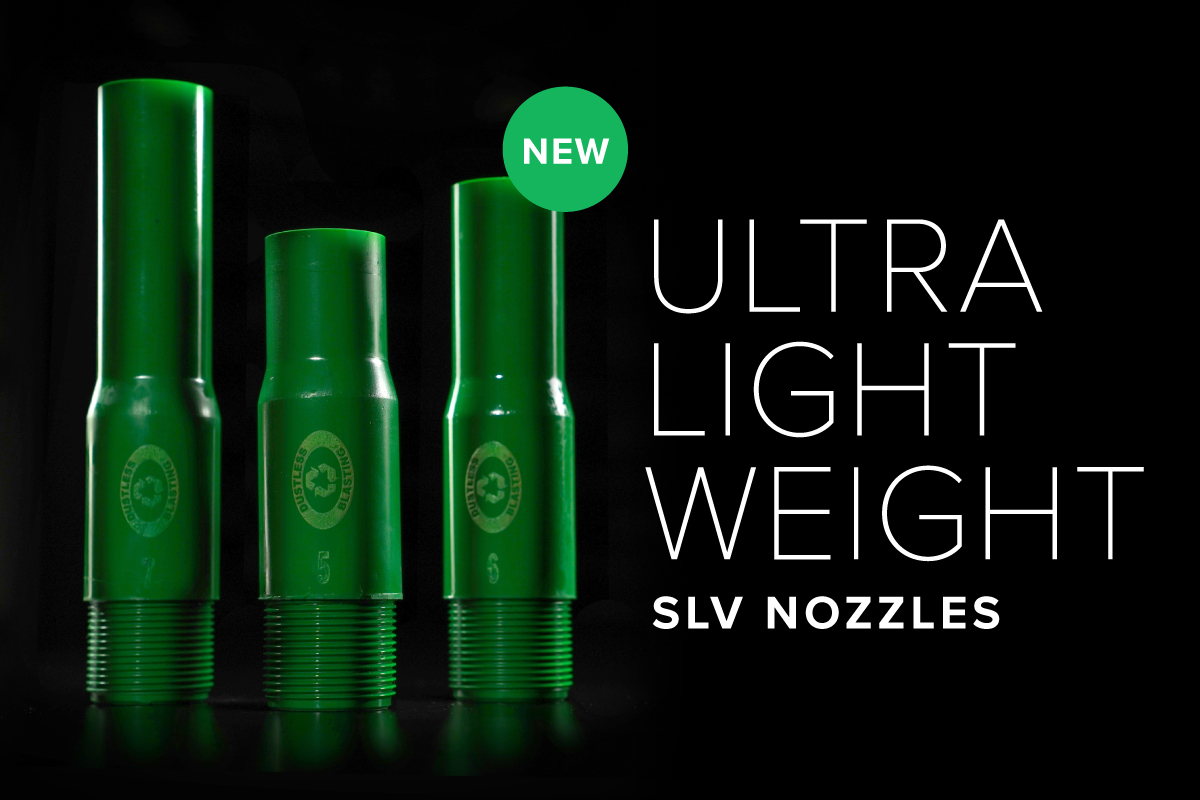
Which size blast nozzle do I need?
Determine the following information to help you discover the most effective nozzle for you:
- What volume of air your air compressor can supply per minute (CFM)
- Desired nozzle pressure (PSI) you want to maintain for productive blasting — this is usually 100 PSI
Keep in mind, that the greater your compressed air supply is, the larger the blast hose and nozzle you will be able to use.
You can consult our chart to help decide which nozzle is right for you.
Additional Types of Sandblasting Equipment
When it comes to options, there are several ways you can go about sandblasting. There is a lot of variety when it comes to equipment you can choose from. For example:
- Blasting rooms
- Abrasive blasting rooms
- Blast cabinets
- Dry ice blasters
- Peening machines
All-in-one trailers are a perfect addition to your mobile sandblasting business. You also get a water tank (which allows you to blast wet if you're not near a water source) and an air compressor, blast pot (pressure vessel), air drying and cooling systems.
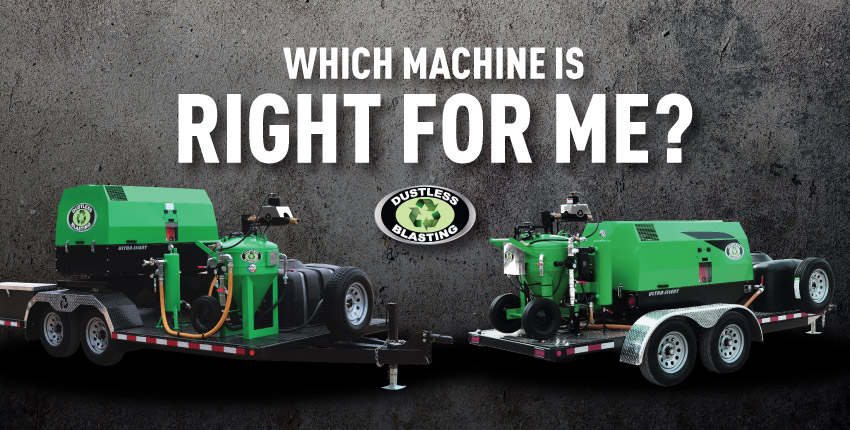
Free Download
The Complete Dustless Blasting Catalog
Explore pricing, equipment, the industry, and everything you need to know.
Sandblasting Media
Sandblasting media is typically fine-grained, monocrystalline sand that has been treated to remove contaminants. It is available in different grades of coarseness, depending on the desired blasting results. Media must be dry when used so it can be recycled through the system during each cycle because wet media will clog the equipment.
Sandblasting Media Selection
In general terms, the blasters should select media to blast with based on the following:
- Vibratory feeders - Wet or dry abrasive?
- Classification - Size and shape of product being blasted
- Coatings - What is being removed from the surface?
When using wet vs. dry abrasives, consider this: The efficiency and high velocity of wet blasting is typically lower than for dusts; therefore, less product is removed and there is less media usage. Wet also decreases the life of the nozzle assembly due to the high pressure necessary to blast through water. On the other hand, wet can remove heavy coatings such as iron phosphate, epoxy paints and polymer corrosion inhibitors that could otherwise be difficult or impossible for dry media to remove
The size, shape and hardness of particles can be classified by sieve analysis. The average mesh size and shape (roundness) determines the media performance/efficiency, surface finish and economical usage.
Media Options
Sand is the most often used media in sandblasters, because it is round and hard, making it easy to work with. An abrasive that has sharp edges will cut into the surface being treated very quickly, perhaps too quickly depending on the application. If the media is too soft, it will not cut into deeply pitted surfaces enough to adequately clean them. If the media is too rounded, or has some other irregularity (such as a warp or bend in the material), it may bounce off of some areas and deposit too much material on others. Another media option used frequently, with less of the downsides of using sand, is recycled bottle glass. This media has a very sharp, glassy edge that can be used to cut into surfaces much faster than sand, but is not as likely to cause damage because it is smooth.
Glass beads are also used as an abrasive media, and will last longer than sandblasting media due to the reduced wear on the media itself. However they are heavy, causing the machine to have slightly less mobility.
Choosing the Right Sandblasting Media
Last week we talked about the merits of soda blasting and its media: baking soda. Sandblasting affords you more options. Sand is one of the ingredients that go into making glass bead blasting media; however, because it's not actually glass itself, it cannot be referred to as such. If you're looking to buy sandblasting media, you should read the product description carefully to make sure it's the right type for your needs. The key to getting the best results is to make sure you're aware of how the blasting medias are different and when each is the best option for the particular projects you are working on.
Sandblasting Media Types:
Again, sandblasters very rarely use sand as the blasting media due to potential environmental and health hazards. But you don't need to worry about that because there are several better options for your abrasive blasting needs. These alternatives are great for removing tough coatings from a variety of surfaces.
- Steel shot is an abrasive media that consists of small steel balls (typically 1/16 square inch or smaller). It is commonly used for grinding and polishing metal surfaces as well as paint removal.
- Steel grit is another option for the steel abrasives side, in addition to steel shot, that consists of small steel particles (typically 1/16 square inch or smaller). It's commonly used for grinding and polishing metal surfaces.
- Power sand is an abrasive media that is very similar to steel shot; however, it has a softer composition which makes it safer to use on certain materials. Commonly used for paint removal, grout removal and tile preparation.
- Acrylic media is a safe alternative to steel grit and power sand. It's non-toxic, chemical resistant and reusable. Acrylic media works well for most applications including light etching of metal surfaces, surface finishing on plaster, concrete surfacing and cleaning of weld joints among others.
- Recycled glass media is an environmentally friendly alternative to steel shot and other types of sandblasting media. It's safe for the environment, produces less dust collection and fumes and can be recycled time and time again. Commonly used for paint removal, surface preparation on plaster surfaces and metal cleaning among others.
- Walnut shells. Yes. Walnut shells. This abrasive blasting media option does minimal damage to the primer layer below or any coating that has been applied to an object.
Coatings
Particle coatings or contaminants will have an effect on abrasive selection as well as blasting results. Coatings such as rust and old paint, mill scale, epoxy coatings, zinc plating, rubber deposits, grease and oil can either be removed quickly or not at all. While some coatings are more difficult to blast cleanly than others, the size of the particle is often a determining factor. The smaller the coating particle size, the more difficult it is to remove.
For example, some powder coatings can be removed easily while polymer corrosion inhibitors are very difficult to blast completely after they have been exposed to air for a short period of time. Coatings that are blasted off in pieces rather than being abraded into small particles leave a rough surface, which in turn results in a poorer appearance.
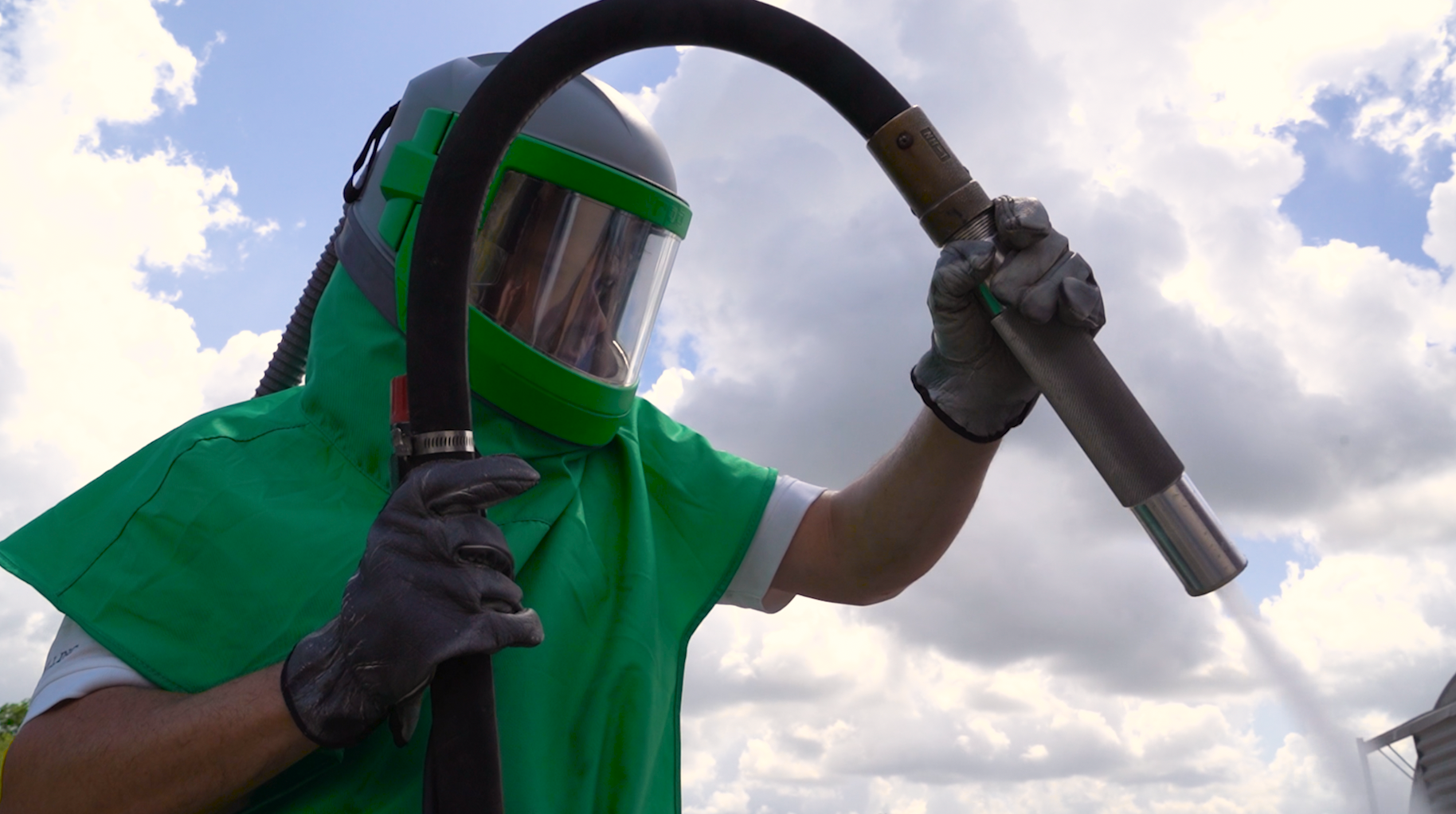
BLOG ARTICLE
SODA AS A BLAST MEDIA
Learn more about using Sodium Bicarbonate for blasting applications.
READ THE ARTICLE
Safety Tips While Abrasive Blasting
Abrasive blasting is an operation that involves two primary sources of danger: electricity and gases. So, in order to work in this environment safely, you need to familiarize yourself with the basic safety rules. We will discuss these below.
Dangers of Electrical Equipment
Electrical equipment must not be used within 50 feet of the blasting site unless it is specifically designed for use in hazardous locations. Abrasive-blasted areas must be grounded by qualified personnel according to the standards set forth by OSHA or other applicable safety standards. Although most abrasive-blasting operations are performed in the open, they can also be performed inside buildings or other enclosed areas. In these cases, all electrical panels, switches and outlets should be taped in order to prevent unintentional operation of power in the area where the blasting is being done. All tools used for a sand blaster in enclosed areas must be designed for use in hazardous atmospheres.
Dangers of Gases and Vapors
Abrasive blasting operations produce a variety of potentially dangerous gases and vapors, such as silica dust and fly ash (in coal-fired byproducts), which can cause serious respiratory problems over prolonged exposure.
Protective Clothing
The best way to protect yourself is to always wear respiratory protection (such as an air-purifying respirator) at all times when you are in the vicinity of any hazardous materials. Personal protective equipment (PPE) should be worn anytime you are working around the blasting site. Eye protection is especially important whenever there is a chance of broken material hitting you in the face.
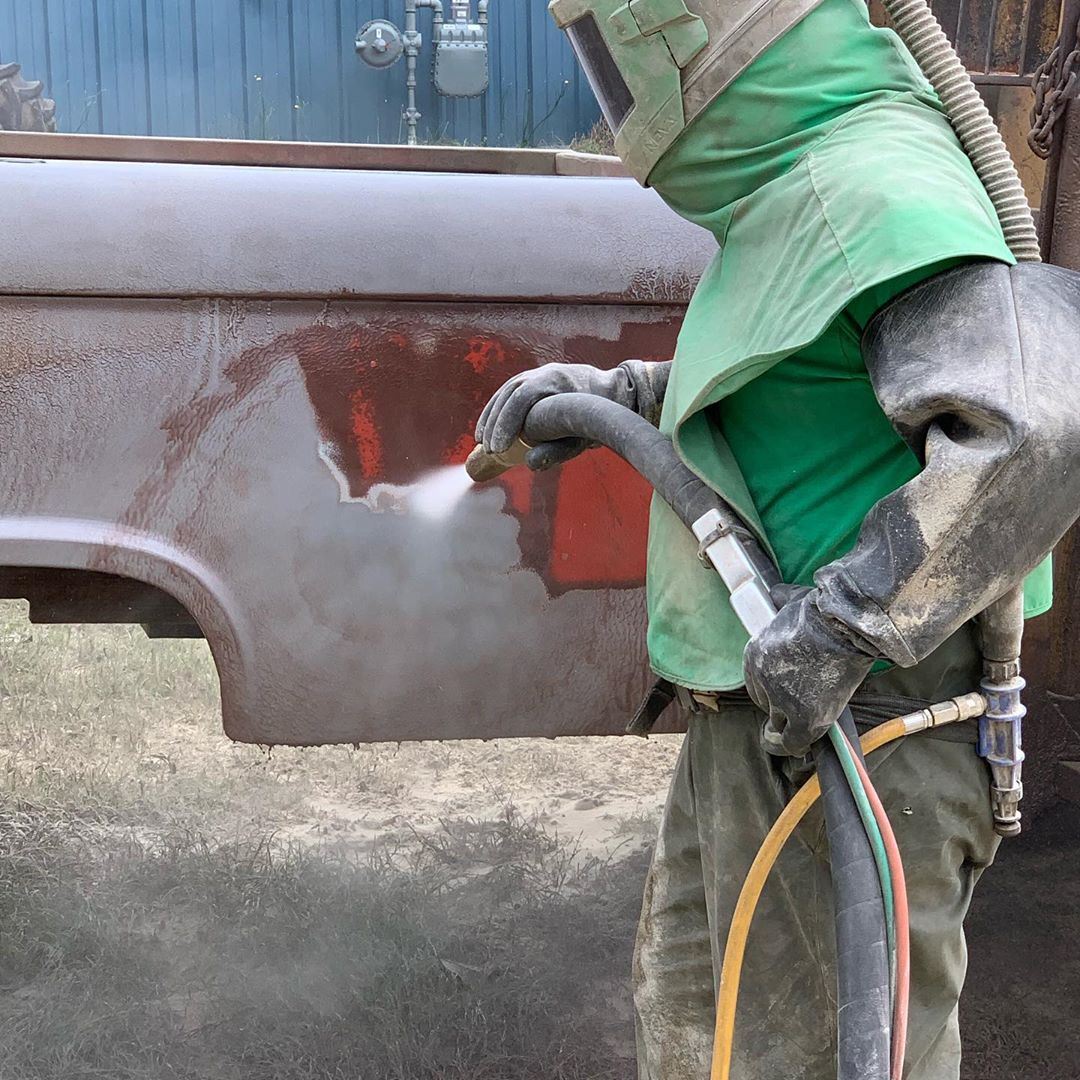
All safety equipment and procedures should be explained in detail before you start the job, so that all workers know what they can expect and how to proceed in case of an emergency. Because the blasting process is very dynamic and even a moment of distraction can lead to accidents, everyone involved in abrasive blasting must be constantly aware of their surroundings and of potential hazards at all times.
Containment: Keeping Your Sandblasting Under Control
While the sandblasting process is a non-destructive method of removing old paint and rust that preserves fine details on a surface like sculptures, architectural elements and automotive parts, the cleanup and containment aspect is not as simple as sweeping up the mess and disposing of it. There are some ways to safely clean up the area and eliminate the health risks and damage upon turning out a finished product when sandblasting.
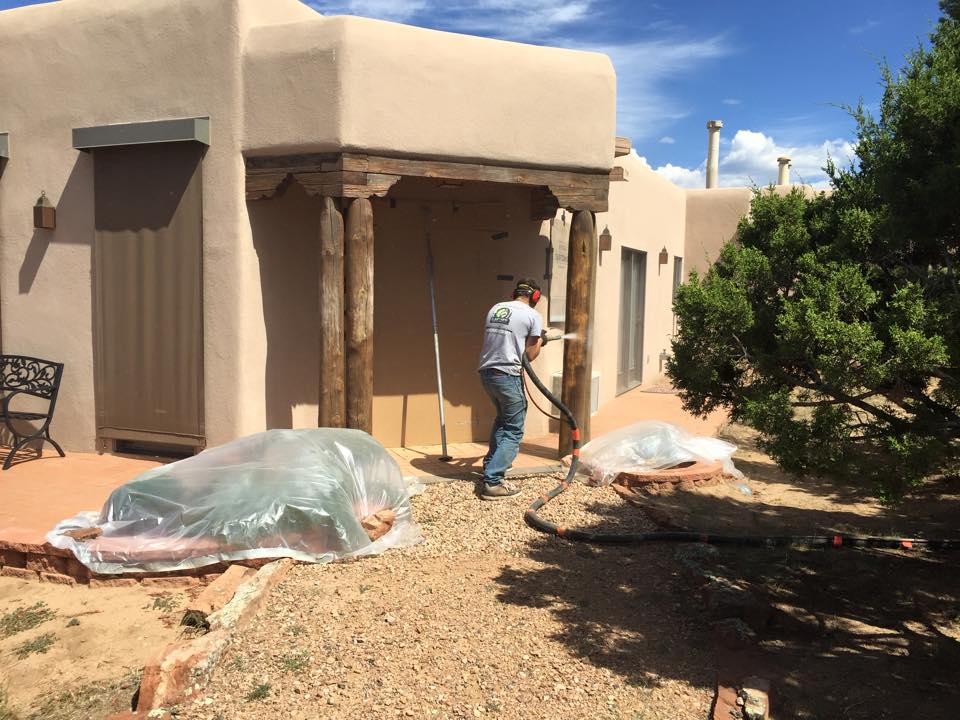
The most important part of the cleanup begins right as you start blasting. Make sure proper containment is in place to protect both you, and anyone working with you, from being exposed to potential health hazards like silica dust particles that fly everywhere during the process. A tent, plastic sheets or a large tarp will work well for creating a containment area that's at least 6-ft tall. If you don't have access to one of these options, try hanging the plastic sheeting over doors and windows.
FAQs About Sandblasting
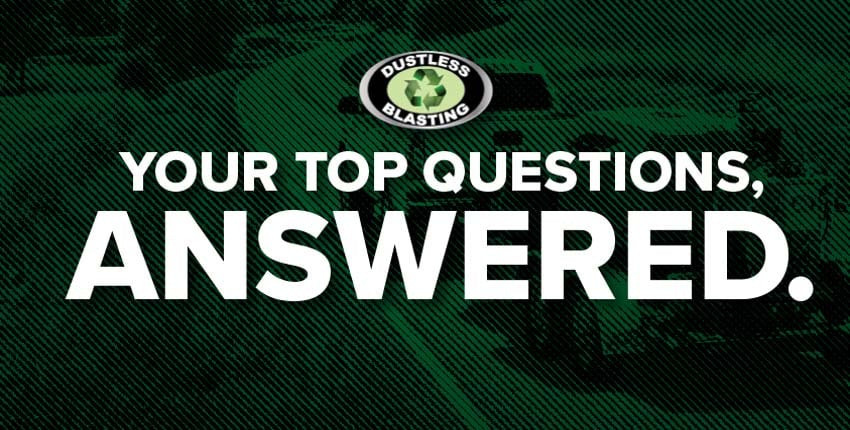
Who should I call to get a small project Sandblasted for me?
There are plenty of Dustless Blasting equipment owners who will be happy to blast your project for you. Search the internet for ‘Dustless Blasting near me’ and get in contact with a local business owner!
Is "Sandblasting" bad?
Dustless Blasting does not use the traditional method of Sandblasting, which can be dangerous when not done correctly and with the right precautionary measures. ‘Sandblasting’ for us refers to dry abrasive blasting which, in combination with the Dustless Blasting process, is safe for both the surface being prepared and the sand blaster themself.
Can Sandblasting remove rust?
Sandblasting is a very effective method for removing rust as well as a variety of other unwanted coatings. Check out this page to see more about what you can remove with Dustless Blasting.
When should I sandblast and when should I wet blast?
Sandblasting is a versatile method of blasting. When you are dealing with projects that have a lot of hard to reach places, such as car chassis or tractors, dry blasting can help your efficiency on the job site by accelerating the cleaning process.
For more information on when to wet blast or dry blast, visit this blog.
Does sandblasting use sand?
The traditional method of sandblasting uses sand as its main abrasive, which when broken down and inhaled can lead to serious respiratory disorders. However with Dustless Blasting, you are able to use a wide variety of blast media. Common forms of dry blast media include crushed glass, corn cob, walnut shell, and more.
Do I need a special nozzle for sandblasting?
For any sandblasting equipment, nozzle selection is very important for getting optimal results. Make sure your air compressor can always provide the appropriate amount of compressed air needed for the nozzle size and type you are using. Inadequate air supply in your air compressor can greatly reduce performance and efficiency.
The Dustless Blasting Opportunity
If you're ready for a change and want to control your future – Dustless Blasting is pioneering a brand new industry – mobile blasting and cleaning. With versatile equipment that is made to move, you can offer a wide variety of onsite services.
Here is what inspired us to create this exciting business opportunity:
- Revenue Potential: The mobile paint stripping and cleaning industry is valued at over $10 billion annually, with strong year-over-year growth.
- High Demand: Look around. Everything is painted, rusty, or dirty. The demand for this service is everywhere, but providers are few and far between.
- Low Overhead / Startup Costs: You can start a business for around $50,000!
- Not Time Consuming: You can be operational in days — not weeks or months.
- High Margins: Need we say more?
- Scalable Growth: It’s easy to scale your business by adding trailers and crew as you grow.
- Smart Risk: We give you the best of both worlds. Benefit from a community of business owners, marketing support, and a trusted brand to help you succeed — all without franchise fees.
Did we mention it's not a franchise?
You work hard for your money, so we believe you should keep all the profits.
- No ongoing fees
- No corporate limitations
- No territories
- Keep 100% of your profits
We believe in setting you up for success, so you can count on training, support, marketing materials, and advertising services.


